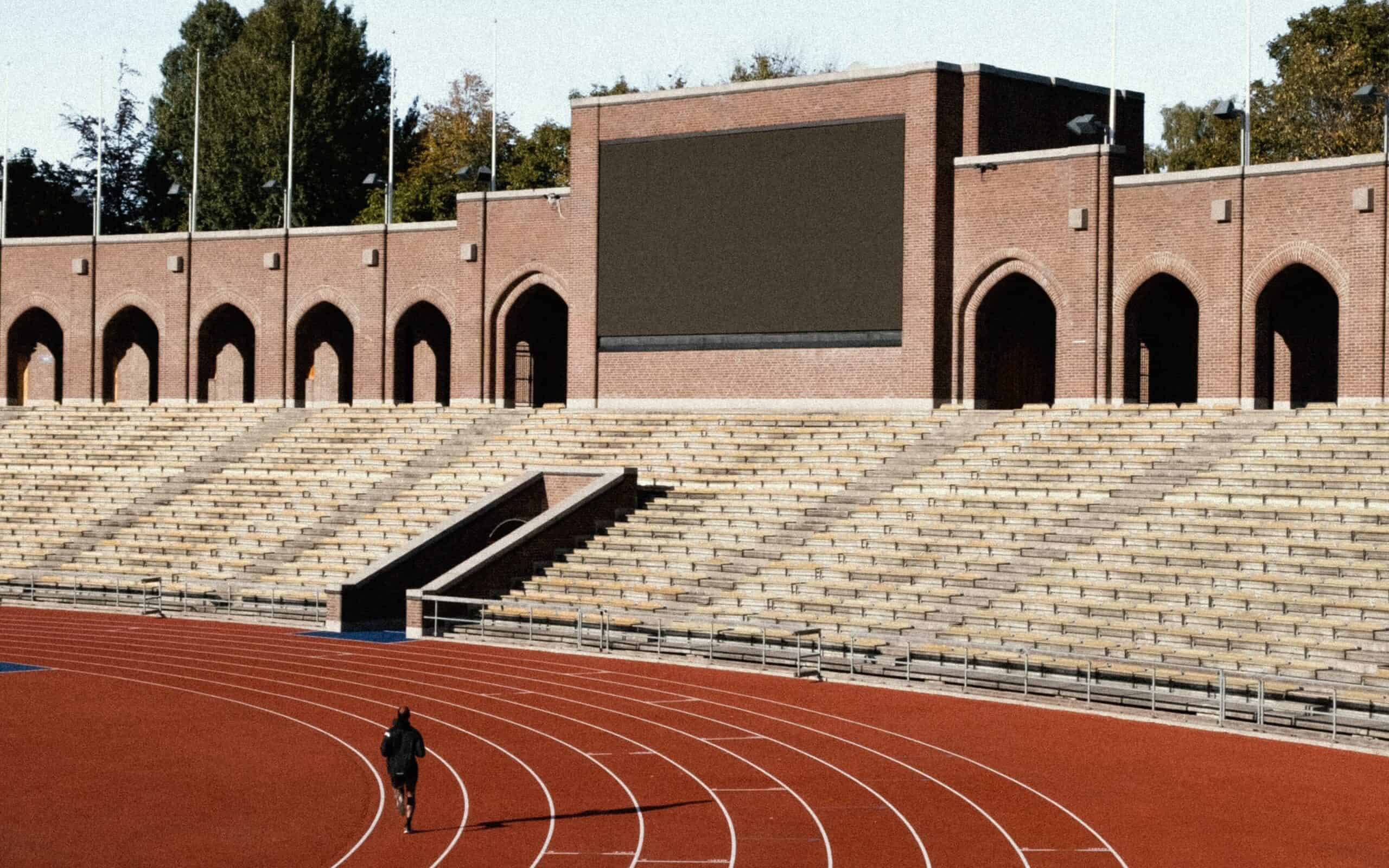When you first started running, you likely knew very little about how to pace yourself or even, if you needed to. You felt invincible, only to be forced to a halt or a slow walk, jog, or crawl only a few hundred feet down the road.
Learning an appropriate, good running pace is a lesson all runners have to learn. Without correct pacing, you’ll not only struggle to complete your runs, but you also won’t improve as much as you would with the correct training routine and pacing strategy.
In this article, we explain:
- What running pace is
- What’s considered a good running pace for different categories (a beginner v. advanced runner, different age groups, genders, etc.)
- And, helpful tips to help you increase your running pace
Whether you’re training for your first 5k, half marathon, or marathon, good running pace should be on your mind.

What is running pace?
Running pace is the average speed at which you run.
It’s measured in minutes per mile or minutes per kilometer.
The longer it takes you to complete a mile, the slower your pace. The quicker you run, the faster your pace. Simple.
In most instances, especially for beginners, it’s not recommended to run one fast mile and then several slow miles unless it’s specifically required by some sort of track workout with interval training.
Instead, a good running pace is one where you can maintain a consistent running speed for the entirety of whatever distance is your run. This advice is standard for most fitness levels.
If you’re running a half marathon, for example, you’d want to do your best to run the same pace every mile for all 13.1 miles.
If you’re aiming for a goal time, like a 3-hour marathon, this strategy would allow you to predict your finish time while minimizing anxiety of missing a goal in the second half of the race and fatigue from going out too quickly.
What is a good running pace for someone who is starting to run?
If you’re a beginner runner, it can be challenging to identify the right running pace.
Is a 9:00 mile a good running pace?
What if I’m just running one mile?
Should I be shorter runs with a faster pace than my longer distance runs?
To break it down simply:
- Your aerobic and muscular fitness requires time to improve depending on how far you’d like to run.
- As you begin running, you simply won’t be able to run a half marathon as quickly as you could a mile run time.
- For beginner runners, there are three ways to determine how quickly you should be running: the rate of perceived effort (RPE), your running heart rate zone, or your ability to conduct the Talk Test.
- These tests are designed to keep runners in your Zone 2 Heart Rate. For a more thorough look on running in Zone 2 and how it improves your running, we have a Slow Running Guide.
- As you begin, if you feel uncomfortable determining your rate of perceived effort like more experienced runners could, invest into a heart rate monitor. We like the Garmin Heart Rate Monitor which has over 18,000 reviews on Amazon.
- You can also invest into a training app like my personal favorite – Runna. Using code HALF you’ll receive 2 weeks of free training from Runna. They’ll assign paces, distance, and cross training along the way.
For a comprehensive per minute mile and their resulting half marathon time, check out our Pace Chart here.
Choosing the right pace for your goals
As a beginner, most coaches will recommend only running slowly during training. You really don’t need to be running high-intensity fartleks on your third week of training.
As you get a few months in and you find more confident pacing yourself, you might decide it’s the right time to add a mix of paces to your training.
You’ll likely have 4 or 5 different training paces for different distances and workouts.
Related: The 13 Types of Running You’ll See in Every Training Plan
You’ll have:
Your Long Run Pace
If you’re training for a half marathon, the core of your long distance training will be the long run. Your long run pace should be 10-20% slower than your marathon pace.
Example: If your goal marathon time is 9:00 per mile. Your long run pace should be between 9:54 and 10:48.
Your Recovery Run Pace
There’s no pace that’s too slow for a recovery run. The metric is 30% to 50% of your effortful runs. So, if you’re running at maximum effort at a 6:00 per mile pace, you should be running your Recovery Runs at 12:00+ per minute pace.
Your Interval/Speed Pace
If you do want to incorporate speed work, aim for a pace that’s 20% faster than your goal time.
Example: If your goal marathon time is 9:00 per mile, your speed work pace should be around 7:12 to 7:40 per mile.
Your Daily Training Pace
These are daily runs of shorter distances than your long runs. Run based on feel but try to train them around your goal time or a little higher .
Example: If your goal average mile time for your marathon is 9:00 per mile, your daily training pace should be between 9:00 and 9:30 per mile.
You don’t have to keep track of these on your own. Use an app like Runna or Strava and they’ll keep track for you.
The Rule of Thumb: Your running pace will vary depending on your level of fitness, your training goals, and the run sessions you’re performing.
If you have a goal time, it can help to follow a structured training program that determines what sessions you’ll run each week and at what pace. This allows you to get the most out of your training with full confidence that you’re running the right pace for each session.

How to find your average running pace
There are a few methods you can use to find your average running pace. However, you should note that your pace will vary depending on the distance and intensity of which you are running.
For example, your pace during a long run will be slower than that of an interval session. When you train at the correct pace — that is, to stimulate the necessary physiological adaptations — you minimize fatigue and get the precise benefits from the session without the risk of overtraining.
Below you’ll find three methods you can use to find your average pace.
Running Pace Calculator
One of the most popular methods to calculate your target running pace is to use a calculator. Simply enter a recent race result, or if you’re a beginner, your best training run, and it will calculate your target running pace for a mix of distances.
If you have a running watch – our favorite is the COROS Pace 2 – you can set a pace reminder to stay on track.
It’s that simple!
Heart Rate Training
We’ve already discussed heart rate. However, monitoring your heart rate is a very popular and easy way to run at the correct pace.
To begin, we’ll show you how to calculate your Heart Rate Zones.
You’ll first need to find your theoretical maximum heart rate (MHR). The formula below is commonly used:
220 – age = MHR
So let’s say that you’re a 35-year-old, then your theoretical maximum heart rate would be 185.
You can now take your MHR and calculate your training zones based on percentages. You will find the training zones below:
| Zone | % of Max Heart Rate | Notes |
| Zone 1 | 50-60% | Very easy recovery |
| Zone 2 | 60-70% | A conversational pace |
| Zone 3 | 70-80% | Challenging but doable |
| Zone 4 | 80-90% | Comfortably hard |
| Zone 5 | 90-100% | All-out effort |
Using the same example of a max heart rate of 185, your Zone 2 running pace — where the bulk of your training will be spent — is 111-130 BPM.
Rate of Perceived Effort (RPE)
RPE is also known as the rate of perceived exertion or effort. It’s one of the oldest methods in the book. It also requires no equipment but because it’s a subjective measure, it may produce inaccurate results.
Typically, RPE is measured on a scale of 1-10. At the lower end of the scale, 1 is very light intensity, usually a walk that can be maintained for hours.
At the upper end of the scale, 10, is an all-out sprint that can be maintained for up to 30 seconds. Most of your training should be done between 2-8.
80% of your training should be done in the 2-5 range.
If you’re a total beginner, aim for an RPE of 3-6 — that is, to maintain a conversation without getting out of breath — for most of your runs.
Rate of Perceived Exertion (RPE)
| 1 | Very light activity (a slow walk) |
| 2-3 | You can maintain an entire conversation |
| 4-6 | You can hold a short conversation |
| 7-8 | Heavy breathing (can speak 1-2 sentences max) |
| 9 | Very difficult |
| 10 | Maximum effort |
When should you increase your running pace?
The more time you spend running, typically, the faster you’ll become. Your current average pace will increase even with the same output of effort. Therefore, it’s essential to calculate your average running pace frequently to ensure you’re training in the right zones to get the biggest bang for your training buck, so to say.
So the big question: when should you increase your running pace?
An easy way to determine your pace is to base it on recent race event results.
For example, if you run a 5k, tailor your training paces based on your results. It may be harder for marathon runners to do this, as races are infrequent.
You don’t want to run too hard too often, but these benchmark results ensure you are training correctly and at the right pace for the best results.
If you train by heart rate or RPE, you’ll naturally increase your running speed.
For instance, the more you develop your aerobic system, the more efficient you become at running speeds you once considered challenging. You still train to the same guidelines, i.e. by heart rate or RPE, but because it’s subjective, you’ll always fall within the correct guidelines.
If you run consistently, your running pace will improve naturally and gradually over time.

How to improve your running pace
So you want to increase your average running pace?
It’s actually pretty simple to do. The quickest and safest way to do it requires a mix of training styles to stimulate the necessary adaptations.
The Rules of Improving Your Running Pace for Beginners
- As a beginner, you should focus primarily on building the habit of running three to four times a week before adding further intensity.
- Increase your weekly distance by no more than 10% each week to minimize your risk of injury.
- You should spend most of your time (80%) running at a conversational pace. usually at zone 2 or a 4-6 RPE.
- Training for long periods at low intensity provides the stimulus for aerobic development. For example, you’ll increase the number of mitochondria in your cells, and capillaries per muscle fiber, your heart becomes stronger and more efficient at pumping blood around the body, and your lungs also become stronger. These adaptations won’t happen overnight, but you should start seeing results in a few weeks.
Most of your training should be slow and steady, you can begin to add sessions such as:
- Tempo runs (10-minute warm-up, 20 minutes slightly slower than your 5k pace, 10-minute cooldown)
- Mile repeats (run 1 mile, rest for 5 minutes)
- Fartlek sessions (unstructured speed training)
- 400m and 800m intervals (jog or walk breaks between intervals)
- Trail running and hill repeats
Although not technically a running session, you should consider adding strength training into your routine.
Weekly strength workouts can improve your running form, and overall fitness, and will reduce your risk of injury.
If creating your own weekly training plan seems overwhelming, you can view our free half marathon training plans here. Alternatively, you should consider working with a running coach or downloading a free training app like Runna – Use code HALFMARATHON for 2 weeks free training.
FAQs
What is a good pace to run a mile?
Running pace varies from person to person and typically depends on how long they’ve been training. However, if you’re a beginner, anywhere from 7 to 9 minutes is often considered a good pace.
What is a decent pace to jog?
Instead of aiming for an exact pace, try and run at 60-70% of your maximum heart rate or 4-6 RPE.
How can I improve my running pace?
Add hills, intervals, mile repeats, tempo runs, and strength training into your routine to improve your running pace.
What is the world record mile pace?
The record for the fastest mile ever run was by Hicham El Guerrouj with a time of 3:43:13.





